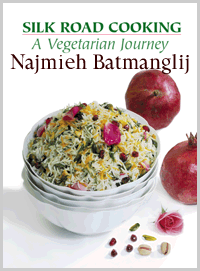 My
Iranian kharoset My
Iranian kharoset
The problem
is that my parents' recipe tastes much closer to what I remember
of our Iranian mixture than mine
Farideh
Goldin
July 14, 2005
iranian.com
Once again, I ask my father to give me our family recipe for
the Passover kharoset (charoset). He says, “Chop walnuts,
almonds and pistachios in a food processor, add apples, bananas,
and grapes
-- only
if you wish--pomegranate juice, wine, and vinegar--as you like--cinnamon
and cloves, and dates and even figs--if you want.” Surprised,
I ask, “Bananas? When did we start adding that? And what
about pomegranate seeds?” My mother interjects, “No,
no, don’t use them. They are -- well--seedy.” My
father adds, “We make it dense for our guests, but, personally,
we prefer it watery.”
But I know this is not our recipe because I was in charge of
making it every year when I lived with my parents in Iran. The
day before the holiday, I burrowed through Passover dishes, fruits,
and vegetables, piled in a large dark pantry, to find the pomegranates
that had hung in our sukkah in the fall. A few spoiled, but most
produced ample seeds, no longer bright red, but sweeter than usual.
I sat on a low stool by the kitchen door, away from the hubbub
of my grandmother, my mother, and my aunt’s preparations
for Passover. Holding a heavy pestle with both hands, I pounded
freshly roasted nuts in a stone mortar. “Don’t beat
them hard; they will turn into oil,” a voice in the background
ordered. I grated apples, added pomegranate seeds, cinnamon, cloves,
and some kind of liquid. Was it wine? This is where my memory fails.
But I am certain that there were no bananas.
In fact, bananas are not native to the Iranian soil, and I had
never tasted one until I was in high school, when an aunt visited
Israel and brought us a few green ones. Not realizing they weren’t
ripe yet, I took a big bite and spat out the bitter pulp. Years
later, Iran would import them and they would become a part of our
diet, but there is nothing traditional about them in the Iranian
kharoset.
 There is a curious irony in the recipe. Although it symbolically
represents our days of slavery in Egypt and our toiling in the
mud (the kharoset is made to resemble mud in almost all recipes),
it is often made with luxurious, even exotic ingredients to attest
to our resilience, our triumph in reclaiming freedom, and our celebration
of life. Indeed my parents have adopted new ingredients in their
recipe and have forgotten the original one that I recall. The problem
is that their kharoset tastes much closer to what I remember of
our Iranian mixture than mine. And that’s the reason I pester
them about the ingredients every year. There is a curious irony in the recipe. Although it symbolically
represents our days of slavery in Egypt and our toiling in the
mud (the kharoset is made to resemble mud in almost all recipes),
it is often made with luxurious, even exotic ingredients to attest
to our resilience, our triumph in reclaiming freedom, and our celebration
of life. Indeed my parents have adopted new ingredients in their
recipe and have forgotten the original one that I recall. The problem
is that their kharoset tastes much closer to what I remember of
our Iranian mixture than mine. And that’s the reason I pester
them about the ingredients every year.
Finally, one year I demand that they must bring all ingredients
to make the kharoset in front of me when they visit for Passover.
In my adopted home in Virginia, they throw nuts, apples, bananas,
and dates -- just as they had told me -- in my pesadik food
processor. Then my father opens a sack and carefully removes a
well-wrapped bottle. As I watch, I remember him in our kitchen
in Shiraz, opening a locked cupboard and handing me a bottle of
homemade wine vinegar, the secret ingredient. When he opens the
bottle in my kitchen, the room fills with the aroma of Passovers
past, of a home lost, of a community in disarray.
copyright © Farideh Goldin About
Farideh Goldin is the author of Wedding Song: Memoirs of
an Iranian Jewish Woman, (Brandeis UP, 2003). Visit FaridehGoldin.com.
|